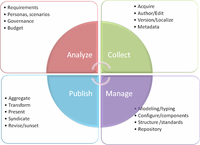CONTENT MARKETING STRATEGY

This content can be seen in various forms; videos, data sheets, white papers, Webinars/Webcasts, ROI calculators, case studies, testimonials and more. Before you try to provide this level of depth and relevancy, your company should have a content strategy. Developing a content strategy requires patience and various steps that include defining your audience, identifying content gaps, identifying content experts, generating content, posting content, and ongoing content management. Let’s look at each step.
Define your audience
We start the process out by defining your audience. You should understand who your customers are, how they make buying decisions, and what type of information they need to feel comfortable about making their buying decision.
Even if your company sells only a few types of products, your customers’ buying behavior can vary widely. Typically, there are three types of buyers. You will likely need content to meet the information needs of each of these buyers:
- Analytic buyers – concerned about whether the product being considered can solve the problem they face.
- Technical buyers – concerned about how well a product/service works or fits within their company’s environment.
- Economic buyers – concerned about achieving a return on investment for their purchase.
Identify gaps in content
Once you understand your audience, it’s time to assess your existing library of content to see how it matches up to your audience’s needs. You probably already have a lot of content: Presentations, PDFs, blog entries, Web pages, case studies, perhaps some videos and Webcasts and white papers.
Gather and organize all of your content and map it to one of your three buyers. Look for what’s missing? Depending on what you have it could be a lot. If you may have new products/services coming out, you’ll need to develop content for those as well. This is also a good time to archive/purge any content that is no longer relevant in terms of messaging or positioning.
Identify content experts internally
You have content experts in your midst. They may not be scholars at writing but they know your product and services inside out as well as how those product and services fulfill a need for your audience. It’s important to interview these experts on a regular basis. You can record the sessions and then turn that recording over to someone like us to create new relevant content for each audience.
Generate new content
Even if you have a lot of new content to create, the good news is you don’t have to tackle it all at once. You should prioritize the most important pieces that need to be created. There’s a good chance you can re-use some of your existing content. For example, you might be able to take a technical white paper and turn it into a best-practices article or a series of articles for an analytic buyer.
The ROI calculator is great for an economic buyer. The economic buyer also likes customer case studies and video testimonials that talk about the financial benefits of your products/services. For analytical buyers, try a white paper that explains your company’s innovative approach to solving a customer problem.
Post content to your audience
You probably already know that the vast majority of buyers go online to find content, and that’s where you should focus your publishing efforts. Your content obviously needs to be placed on your website but it also needs to be loaded on various social sites, article directories, video directories, etc.
Your sales team should also use this new content. They can send different PDF’s of the content to prospects their working with. It provides a reason for another touch point.
Manage content going forward
One advantage of publishing content online is that you can see how popular it is with your audience by tracking various analytics like page views, click-throughs, downloads, and time spent viewing videos. These statistics can help you identify what content is more important to your audience/s. When a particular piece of content has a high rate of audience interaction you will want to create more content just like it.
You’ll also want to track all of your content in a content matrix. You can use something as simple as a spreadsheet to accomplish this. Create fields in your spreadsheet for format, publication date, audience, metrics, expiration date, etc. You should move content that is no longer relevant to another tab within your spreadsheet as to archive it. It’s always a good idea to archive old articles as long as they have some relevant search fields to find them later if needed. You never know when you might want to reference back to a time before or show how you’ve been handling a specific area for a long time.
Every three to six months you should re-evaluate your audience and content strategy to make sure it’s still hitting the mark. Times change, people’s needs change, products change, etc. It’s important that you plan for a time of re-evaluation to make sure the time you’re spending is tied to a relevant strategy that works.
